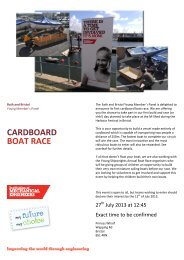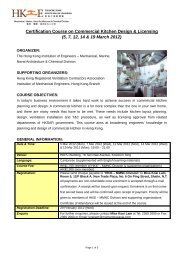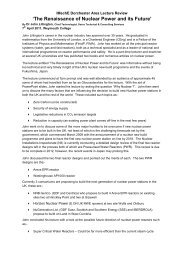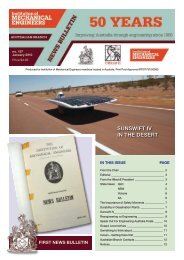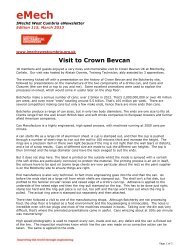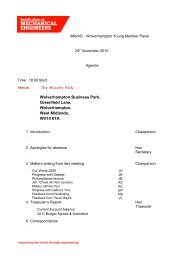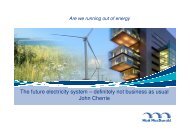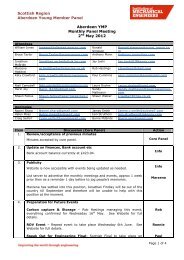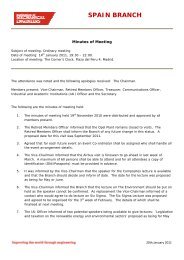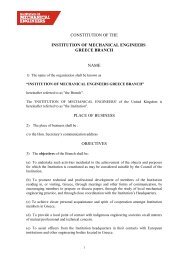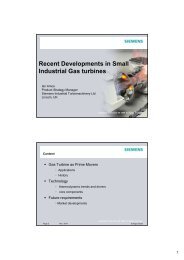Australian Branch - Near You - Institution of Mechanical Engineers
Australian Branch - Near You - Institution of Mechanical Engineers
Australian Branch - Near You - Institution of Mechanical Engineers
Create successful ePaper yourself
Turn your PDF publications into a flip-book with our unique Google optimized e-Paper software.
oN thE iNsidE<br />
NB<br />
News Bulletin<br />
<strong>Australian</strong> <strong>Branch</strong><br />
nuMber 161 May 2011<br />
Produced for InstItutIon <strong>of</strong> MechanIcal engIneers MeMbers located In australIa<br />
Print Post APProved PP317737/00060<br />
PrIce $4.00<br />
Stobie Pole<br />
Visit to Etsa’s stoBiE PolE Factory<br />
By thE JoiNt tEchNical Program<br />
In february 2011, a group<br />
from the Joint technical<br />
Program consisting <strong>of</strong><br />
members from the sa Panel<br />
<strong>of</strong> the <strong>Institution</strong>, engineers<br />
australia, the raes and Iet<br />
went to the only stobie Pole<br />
factory in australia.<br />
Members <strong>of</strong> the JTP group in front <strong>of</strong> an original<br />
Stobie Pole and a new pole manufactured at the<br />
current factory.<br />
South Australia generally has relatively<br />
small amounts <strong>of</strong> timber suitable<br />
for making power and telegraph<br />
poles. To make matters worse, large<br />
areas are prone to white ant and<br />
termite infestation. So, an alternative<br />
A member <strong>of</strong> ETSA explains the manufacturing<br />
stages <strong>of</strong> the Stobie Pole to JTP visitors.<br />
• Editorial<br />
• From the Chair<br />
• Value for Members<br />
• Latest technologies and practical notes<br />
on gas turbines for <strong>of</strong>fshore applications<br />
• Panel News<br />
was required. Steel and concrete poles<br />
(called Stobie Poles) were designed<br />
by the late J. C. Stobie in 1924 when<br />
he was the chief design engineer for<br />
ETSA in South Australia. The basic<br />
design consists <strong>of</strong> two steel c-channels<br />
spaced at predetermined distances<br />
and then filled with concrete. Bolts<br />
running through the concrete between<br />
the two beams take on the role <strong>of</strong><br />
A beam-bending machine originally purchased<br />
from the UK in the 1950s is still fully operational<br />
today and used on a regular basis in the<br />
manufacture <strong>of</strong> the poles.<br />
A new manufacturing plant for the manufacture<br />
<strong>of</strong> Stobie Poles was made operational in 2008.<br />
• Interview: Andrew Lezala<br />
• Running Melbourne’s Train Network<br />
• A Man for All Reasons<br />
• Speak out for Engineering<br />
• Something to Think About
2<br />
Visitors to the ETSA Stobie Pole Factory study background material on the manufacture and use <strong>of</strong><br />
the poles.<br />
reinforcement rods, ensuring added<br />
stability and load-bearing capability.<br />
Originally, the poles were made<br />
individually. This labour-intensive<br />
process became mechanised in 1950,<br />
when the average throughput <strong>of</strong> the<br />
factory was 14 poles per day.<br />
Following the sale <strong>of</strong> the old property<br />
at Angle Park. South Australia in<br />
December 2006, a new mechanised<br />
plant was required. This plant,<br />
also located in Angle park started<br />
production in April 2008, leading to<br />
an increase in production throughput<br />
to 25 units per day.<br />
A pole that has been filled with concrete is<br />
prepared so that excess concrete can be<br />
washed <strong>of</strong>f prior to curing.<br />
news bulletin – no.161 mAy 2011<br />
Modern poles vary in length from<br />
9 to 36 metres and the current<br />
facility consists <strong>of</strong> two separate<br />
production lines: the mechanised<br />
plant (where poles are made from 9<br />
to 15 metres using semi-automated<br />
processes) and the heavy-section<br />
line (where poles are made mainly<br />
for transmission lines from 15 to 36<br />
metres, using old manual processes).<br />
The majority <strong>of</strong> mechanised poles are<br />
for ETSA›s distribution system and are<br />
generally up to 13 metres in length.<br />
Most poles are used to replace old<br />
or damaged units, with only a small<br />
minority used for new lines.<br />
A Stobie Pole is bolted to the correct spacing<br />
and is ready for filling with concrete.<br />
The JTP group was treated to<br />
an excellent tour <strong>of</strong> 1.5 hours,<br />
including detailed explanations <strong>of</strong><br />
the manufacturing process and the<br />
intricacies involved in achieving<br />
consistent quality and no rejects.<br />
The JTP would like to thank ETSA<br />
Utilities for providing some <strong>of</strong> the<br />
above information and for making<br />
available time and personnel to host<br />
the group.<br />
Michael riese<br />
While the mechanised part <strong>of</strong> the factory is<br />
capable <strong>of</strong> producing almost every pole size,<br />
some oversized poles, such as the one shown<br />
here, are still manufactured by hand using the<br />
traditional method.<br />
A pole is bolted to the correct spacing. The bolts<br />
also act as reinforcement rods. The plastic caps<br />
are the cores for future fixture holes that will be<br />
mounted to the pole once it is erected on site.
Editorial<br />
New-look Bulletin<br />
It is my pleasure to introduce the newlook<br />
Bulletin. Based on the feedback<br />
received from the survey conducted in<br />
September 2010, the layout is now<br />
more contemporary and, hopefully, will<br />
make for easier reading. Also changed<br />
is the outside back cover, which now<br />
carries social content. We are aware,<br />
however, that there is always room for<br />
improvement, and we encourage your<br />
feedback and ideas.<br />
From thE chair<br />
Welcome to the May 2011 edition<br />
<strong>of</strong> the News Bulletin. In NB 160’s<br />
‘From the Chair’, did anyone pick the<br />
deliberate mistake? In the message,<br />
I stated that this would be my last<br />
Chairman’s message, because the<br />
new Chairman would be elected at<br />
the February AGM. I was assuming<br />
that this News Bulletin would be<br />
issued after the May IMechE AGM<br />
in London. That, in fact, is when the<br />
new <strong>Branch</strong> Committee will <strong>of</strong>ficially<br />
take <strong>of</strong>fice (see below). However, this<br />
News Bulletin will be issued before<br />
the IMechE AGM. So, in effect, I am<br />
still <strong>Branch</strong> Chairman until 25 May.<br />
This one slipped through scrutiny and<br />
I apologise for any confusion I may<br />
have created.<br />
To reflect on events over the past<br />
three to four months, I should like to<br />
begin with a report on an International<br />
Strategy Board teleconference with<br />
various Regional members, which was<br />
held on 15 February. Highlights <strong>of</strong> this<br />
teleconference were:<br />
• Summary <strong>of</strong> progress on the plan<br />
for the new India <strong>Branch</strong>. The<br />
President was scheduled to visit<br />
India in April to further encourage<br />
effective working relationships with<br />
companies across India.<br />
• Summary <strong>of</strong> progress on the plan for<br />
China. This included:<br />
º Establishment <strong>of</strong> four student<br />
chapters at universities in<br />
Southern China.<br />
I am delighted to have worked on<br />
this issue with the new editor, Matt<br />
Springer, who will take over from the<br />
next issue. Matt is a young engineer<br />
from Melbourne who has lots <strong>of</strong> ideas<br />
and enthusiasm – we are lucky to<br />
have him.<br />
For the moment, the Bulletin will<br />
continue to be mailed to all members<br />
in hard copy. However, an email<br />
notification will also be sent to all<br />
members who have provided an email<br />
address in their membership details<br />
with a link to a pdf copy <strong>of</strong> the latest<br />
issue (uploaded to the <strong>Near</strong> <strong>You</strong><br />
º Launching <strong>of</strong> a design competition<br />
to encompass the greater China<br />
region.<br />
º Accreditation <strong>of</strong> two to three<br />
university engineering courses<br />
relating to automotive and<br />
mechanical engineering.<br />
º Establishment <strong>of</strong> company-based<br />
registration schemes at a shipyard<br />
and automotive manufacturer.<br />
º Planned visit by the President<br />
John Wood and the CEO Stephen<br />
website). Future issues will also be<br />
more electronic-friendly – for example,<br />
hyperlinks to related articles will be<br />
provided.<br />
I would like to thank members who<br />
have sent in articles, ideas, suggestions<br />
and words <strong>of</strong> encouragement. Also a<br />
word <strong>of</strong> thanks to past editors Stan<br />
Gaffney and Tony Creedy for their<br />
encouragement and support, and to<br />
the <strong>Branch</strong> Committee for helping out.<br />
It has been an absolute pleasure and I<br />
wish Matt and the future <strong>of</strong> the Bulletin<br />
all the very best.<br />
roshan dodanwela<br />
Tetlow, who visited Hong Kong<br />
and China in late 2010.<br />
• The formation <strong>of</strong> new groups in<br />
Greece, Switzerland, Italy, Spain and<br />
Texas (USA).<br />
The 51st <strong>Australian</strong> <strong>Branch</strong> AGM was<br />
held in Perth on 26 February. As<br />
reported in the last edition <strong>of</strong> the News<br />
Bulletin, the new Chairman will be<br />
Ian Mash and the new Hon. Secretary<br />
will be Dayaratne Dharmasiri. Ken<br />
Tushingham will continue as Hon.<br />
Treasurer and the new Assistant Hon.<br />
L to R: David Heppenstall (Western <strong>Australian</strong> Panel Chair), Ian Mash (<strong>Branch</strong> Chairman elect<br />
2011/12), Clive Waters (Current <strong>Branch</strong> Chairman), Ken Tushingham (<strong>Branch</strong> Treasurer),<br />
John Burt (Victorian Panel Chair), Michael Riese (South <strong>Australian</strong> Panel Chair), Matt Springer<br />
(<strong>Branch</strong> Assistant Hon. Secretary and News Bulletin Editor Elect 2011/12), Daya Dharmasiri<br />
(<strong>Branch</strong> Hon. Secretary Elect 2011/12), Leslie Yeow (Queensland Panel Chair)<br />
[Absent: Monika Sud (NSW Panel Chair), Roshan Dodanwela (Current <strong>Branch</strong> Assistant Hon.<br />
Secretary and News Bulletin Editor)]<br />
news bulletin – no.161 mAy 2011 3
4<br />
Secretary/News Bulletin editor will be<br />
Matthew Springer.<br />
Also on 26 February, the 80th<br />
<strong>Australian</strong> <strong>Branch</strong> Committee<br />
meeting (face-to-face rather than<br />
a teleconference) was held. As<br />
well as the Executive, Panel Chairs<br />
were present, with apologies from<br />
Monika Sud (NSW Panel Chair), John<br />
Pumwa (PNG Representative), Mark<br />
McKenzie (<strong>You</strong>ng Member Chair)<br />
and Roshan Dodanwela (Asst. Hon.<br />
Sec./News Bulletin Editor who was,<br />
unfortunately, suffering from a virus)<br />
The <strong>Australian</strong> final <strong>of</strong> the Speak out<br />
for Engineering competition was held<br />
in between the committee meeting<br />
and AGM.<br />
On behalf <strong>of</strong> the <strong>Branch</strong> Committee,<br />
I should like to express our thanks<br />
to David Heppenstall, the WA Panel<br />
Chairman, and his team for their<br />
excellent organisation in making these<br />
meetings at the Seasons <strong>of</strong> Perth Hotel<br />
such a success.<br />
The Andrew Fraser Prize was again<br />
awarded on 8 April to a student at the<br />
University <strong>of</strong> Technology, Lae, Papua<br />
New Guinea, by our representative<br />
Pr<strong>of</strong>essor John Pumwa, Head <strong>of</strong> the<br />
<strong>Mechanical</strong> Engineering department.<br />
The Asia and Oceania Regional<br />
meeting took place over the weekend<br />
ValUE For mEmBErs<br />
branch financial Position<br />
following a lengthy discussion<br />
during the branch committee<br />
meeting on 26 february,<br />
and subsequent to a request<br />
made during the agM, the<br />
branch committee has been<br />
progressing a robust dialogue<br />
with hQ in respect to the<br />
financial position <strong>of</strong> the branch.<br />
Members might be interested to know<br />
that the <strong>Australian</strong> <strong>Branch</strong> submitted<br />
a budget to HQ totalling $56,550<br />
to cover all 2011 planned activities,<br />
which service our 1504 members.The<br />
<strong>Branch</strong> was advised that our 2011<br />
grant will be 20,000 UKP, or about<br />
$31,628. This represents a reduction<br />
<strong>of</strong> about $25,000 or 44 per cent.<br />
news bulletin – no.161 mAy 2011<br />
<strong>of</strong> 9/10 April in New Delhi, India.<br />
Our <strong>Branch</strong> Hon. Treasurer Ken<br />
Tushingham who is also the Regional<br />
Chairman and Ian Mash, the <strong>Branch</strong><br />
Chairman-elect, attended.<br />
In NB 160, I described the preparation<br />
<strong>of</strong> potential applications to the<br />
Engineering Heritage Award committee<br />
for several artefacts <strong>of</strong> engineering<br />
excellence. I am pleased to announce<br />
that the Boulton & Watt steam engine<br />
displayed in the Powerhouse Museum<br />
in Sydney is due to receive an IMechE<br />
Engineering Heritage Award. The<br />
engine was one <strong>of</strong> the earliest rotative<br />
steam engines to be built and is the<br />
oldest in existence. It is also one <strong>of</strong><br />
the oldest in the world that still works<br />
regularly under steam. This will be the<br />
first time that the IMechE has granted<br />
the Heritage Award to an artefact<br />
outside <strong>of</strong> the United Kingdom.<br />
Also, an application for the<br />
Humphrey Pump at Cobdogla, South<br />
Australia, has now been submitted<br />
to the Engineering Heritage Awards<br />
Committee for recognition <strong>of</strong> the UK’s<br />
engineering excellence.<br />
The application for the1855<br />
Locomotive (No. 1), also described<br />
in NB 160 and also resident at the<br />
Sydney Powerhouse Museum, will be<br />
submitted to the EHA Committee by<br />
the time this Bulletin is issued.<br />
A dialogue with HQ continues in order<br />
to seek an understanding <strong>of</strong> how this<br />
issue could be resolved without our<br />
need to reduce those few activities that<br />
incur costs. During discussions, the<br />
<strong>Branch</strong> clarified for HQ that:<br />
• the funding requested was the<br />
minimum required to fund those few<br />
activities we incur costs for.<br />
• the majority <strong>of</strong> this funding is<br />
used to print and issue to our<br />
members the three editions <strong>of</strong> the<br />
News Bulletin each year – the only<br />
<strong>Australian</strong>-focused communication<br />
the members receive, and something<br />
we felt the Trustee Board and ISB<br />
would support as being a core<br />
activity <strong>of</strong> our <strong>Branch</strong>.<br />
Finally, and once again, I should like<br />
to express my thanks to all <strong>Branch</strong><br />
Committee and non-Committee<br />
members, for all the assistance you<br />
have given me during my term as<br />
Chairman <strong>of</strong> this <strong>Branch</strong>. I have<br />
thoroughly enjoyed my tenure and I<br />
wish the incoming Chairman and his<br />
committee all the very best <strong>of</strong> luck in<br />
the ensuing two years.<br />
Clive Waters<br />
• for our other activities, the <strong>Branch</strong><br />
typically incurs:<br />
º few or no costs for lecture theatres<br />
for the delivery <strong>of</strong> the technical<br />
programme <strong>of</strong> 50 or so events<br />
nationally per annum.<br />
º few or no costs for refreshments<br />
prior to these lectures.<br />
º few or no costs for presenters<br />
who take the time to prepare and<br />
present papers.<br />
º few or no cost for the quantity <strong>of</strong><br />
pr<strong>of</strong>essional interviews undertaken<br />
by our volunteers.<br />
º few or no cost for the state Panel<br />
activities that organise the learned<br />
institution events enjoyed by our<br />
members; and,
º no costs for work in compiling,<br />
editing and making each edition <strong>of</strong><br />
the News Bulletin ready for print.<br />
Ian Mash<br />
Current Hon Secretary<br />
and <strong>Branch</strong> Chair elect 2011/12<br />
below is a response from stephen<br />
tetlow, the ceo <strong>of</strong> IMeche…<br />
Dear Ian<br />
Thank you for your letter <strong>of</strong> 21 March<br />
advising the Australia <strong>Branch</strong> concerns<br />
on funding and the potential impact<br />
on membership and <strong>Institution</strong> growth<br />
locally and internationally.<br />
I know that you and other members<br />
<strong>of</strong> the <strong>Branch</strong> Executive have had<br />
a telephone conference with Colin<br />
Brown, Director Engineering and Maria<br />
Taylor from the International RIO team.<br />
I hope I have interpreted the outcome<br />
<strong>of</strong> your discussions correctly as I<br />
record the actions below:<br />
Firstly we must double our efforts to<br />
ensure the accounting systems work<br />
quickly. I am pleased to see that you<br />
have agreed a clear new process for<br />
your treasurer to get ‘top-up’ funds<br />
within seven days. I will be watching<br />
closely to check that this process<br />
runs smoothly.<br />
Secondly, I can only emphasise the<br />
importance <strong>of</strong> executive members<br />
meeting with each other to share best<br />
practice and innovate to resolve issues<br />
as they arise not only in Australia<br />
<strong>Branch</strong> but in all regions across the<br />
world. <strong>You</strong>r attendance at the Forum<br />
in Delhi this month and then at the<br />
International Strategy Board here in<br />
London in May are key to improving<br />
the way the <strong>Institution</strong> learns about<br />
what goes on and hence how it can<br />
improve. Many thanks to you and<br />
your colleagues for making the time to<br />
travel and meet.<br />
Finally, in my view the programme you<br />
propose does indeed reflect the desires<br />
<strong>of</strong> the Trustees to engage members<br />
and non-members alike. <strong>You</strong> should<br />
continue to make requests for funding<br />
to deliver that programme even when<br />
your allocated grant is exhausted. We<br />
will make every effort to ensure that<br />
the financial needs for your good work<br />
are met. Clearly anything you can<br />
do to constrain those costs (e.g. by<br />
electronically sending the Bulletin to<br />
the 9 per cent <strong>of</strong> your members who<br />
are happy to receive it that way) would<br />
be much appreciated.<br />
In conclusion, I know that you also<br />
discussed more broadly the aims and<br />
priorities <strong>of</strong> the <strong>Institution</strong>. I have<br />
attached a couple <strong>of</strong> slides that may<br />
be <strong>of</strong> use to you in communicating<br />
that locally. The first one uses<br />
information from our website (http://<br />
www.imeche.org/about-us/annualreview/financial-summary<br />
<br />
)<br />
and shows how we apportion our<br />
expenditure in our goal <strong>of</strong> ‘improving<br />
the world through engineering’. The<br />
second is a list specific to Australia <strong>of</strong><br />
the benefits that I hope your members<br />
to a greater or lesser extent enjoy.<br />
In closing I feel that one <strong>of</strong> the<br />
underlying problems here has been<br />
the 38 per cent reduction in the value<br />
<strong>of</strong> Sterling against the <strong>Australian</strong><br />
Dollar over the last eight years. Whilst<br />
that has reduced the true cost <strong>of</strong><br />
membership for your <strong>Branch</strong>, it has<br />
also clearly reduced the value <strong>of</strong> your<br />
grant by a similar amount. I will make<br />
sure that exchange rate becomes<br />
a more visible part <strong>of</strong> our thinking<br />
in future. Please do contact the<br />
International Team when you require a<br />
top-up <strong>of</strong> funds, via the new process.<br />
Best wishes<br />
Stephen<br />
news bulletin – no.161 mAy 2011<br />
5
6<br />
latEst tEchNologiEs aNd Practical NotEs<br />
oN gas tUrBiNEs For oFFshorE aPPlicatioNs<br />
Considerable demand existed to grow<br />
aero-derivative gas turbine products<br />
in power, efficiency, reliability and<br />
availability for <strong>of</strong>fshore applications.<br />
Clients now want to operate the gas<br />
turbines for longer periods before<br />
shutdown and efficient part-load<br />
operation as well as to mitigate the<br />
various reliability weaknesses such as<br />
various fatigues, fuel quality effects<br />
etc. Practical notes and guidelines<br />
on various gas turbines for power<br />
generation and mechanical drive in<br />
<strong>of</strong>fshore applications are addressed.<br />
Main concerns are best performance,<br />
high efficiency, low maintenance<br />
and compact design as well as<br />
competitive commercial conditions.<br />
This article covers different<br />
performance, mechanical and<br />
reliability aspects <strong>of</strong> main gas turbine<br />
models in today’s market. Latest<br />
achievements and most advanced<br />
technologies are also outlined.<br />
Introduction<br />
High efficiency, compact and light<br />
designs make aero-derivative gas<br />
turbine products the ideal choice<br />
for any <strong>of</strong>fshore application. Aeroderivative<br />
gas turbine components<br />
and modules can usually be replaced<br />
in a very short time, facilitating<br />
maintenance. This article discusses<br />
the latest gas turbine technologies for<br />
<strong>of</strong>fshore applications.<br />
Aero-Derivatives and Multishaft<br />
gas turbines<br />
Aero-derivative machines typically<br />
leave a footprint <strong>of</strong> 45 per cent smaller<br />
and weigh 35 per cent less than<br />
heavy-duty machines with the same<br />
power rating. For <strong>of</strong>fshore and floating<br />
applications, the best (and, in many<br />
cases, the only feasible) option is<br />
aero-derivative gas turbines for power<br />
generation and mechanical drive. The<br />
move towards aero-derivative gas<br />
turbine drivers is also about efficiency.<br />
Aero-derivative gas turbine efficiency<br />
is around 41–45 per cent, compared<br />
to 30–35 per cent for heavy-duty<br />
machines. Aero-derivative machines<br />
use the most advanced aircraft engine<br />
technologies. They have features that<br />
news bulletin – no.161 mAy 2011<br />
facilitate on-condition maintenance,<br />
and a very effective and efficient<br />
monitoring/maintenance method that<br />
considerably increases reliability and<br />
availability. Numerous bore-scope ports<br />
are provided to facilitate inspection.<br />
They allow very intelligent operation<br />
and monitoring <strong>of</strong> gas turbines. Rapid<br />
replacement <strong>of</strong> major modules is a<br />
great advantage; in most cases, major<br />
modules can be removed and new<br />
modules installed so that the turbine is<br />
back in operation within two days.<br />
Avon 200 The modification for the upgrade<br />
can be fitted to the old Avon gas turbine<br />
during the scheduled overhaul.<br />
Avon Gas Turbines<br />
The earliest Avons were introduced<br />
in the 1960s. Since then, more<br />
than 1200 Avons have been sold<br />
worldwide, <strong>of</strong> which more than 900<br />
are thought to be still in active service.<br />
The latest Avon 200 (see Fig. 1)<br />
extends its lifespan further. Avon 200<br />
aims to improve the machine’s gas<br />
generator base load power capability<br />
and thermal efficiency over a higher<br />
ambient temperature range, and to<br />
improve the component robustness to<br />
high-cycle fatigue excitation and hightemperature<br />
creep damage. The power<br />
<strong>of</strong> Avon 200 is 9 per cent greater<br />
(around 19.5 MW compared to 17.5<br />
MW in the Avon 1535) and the heat<br />
rate is 5 per cent greater.<br />
rb211 gas turbines<br />
RB211 gas turbines are widely used<br />
for power generation as well as<br />
mechanical drive. More than 700<br />
RB211 gas turbines have been sold<br />
worldwide. RB211 gas turbines<br />
are <strong>of</strong>fered in various models. Their<br />
power capacity is around 30–44 MW<br />
(depending on the model) and their<br />
efficiency is about 36–41 per cent.<br />
Power turbines can <strong>of</strong>fer a shaft speed<br />
4800 or 6000 rpm for mechanical<br />
drive (depending on the model).<br />
RB211-H63 is the latest version <strong>of</strong><br />
this large family. Its power capability is<br />
around 44 MW, with thermal efficiency<br />
<strong>of</strong> up to 41.5 per cent. This new<br />
model generates at least 11 MW more<br />
power than the old RB211 model.<br />
Modular exchange provides ease <strong>of</strong><br />
maintenance. Full load power can be<br />
obtained in ten minutes from cold.<br />
titan gas turbines<br />
The Titan 250 is the latest model<br />
<strong>of</strong> the Titan gas turbine family and<br />
extends the power output range to<br />
22.4 MW. It is available for use in<br />
a mechanical drive package and in<br />
generator drive sets. It is a two-shaft<br />
design. The package has a footprint <strong>of</strong><br />
approximately 10.5 x 4 x 4.2 m and<br />
weighs around 51 t. The Titan 250 can<br />
produce 50 per cent more power than<br />
the Titan 130 with the same footprint,<br />
is 40 percent more efficient and has<br />
a 30 per cent reduction in emissions<br />
compared to the Titan 130. It uses<br />
variable inlet guide vane technologies<br />
for efficient part-load operation. It<br />
incorporates a vertically split casing<br />
design. The combustion chamber uses<br />
annular-type, lean-premixed, dry, and<br />
low-emission design technology. It is<br />
designed to operate on a broad range<br />
<strong>of</strong> gaseous and liquid fuels. The power<br />
turbine section is a three-stage reaction<br />
type with a maximum speed rating <strong>of</strong><br />
7000 rpm.<br />
lM2500 gas turbines<br />
The LM2500 family is the most<br />
popular gas turbine for industrial use.<br />
There are more than 2600 LM2500<br />
sold for various applications. The<br />
LM2500+ gas turbine is a 31MW<br />
aero-derivative two-shaft machine<br />
with efficiency <strong>of</strong> about 40 per<br />
cent. It is derived from the LM2500<br />
engine but increases its airflow and<br />
pressure ratio by around 23 per<br />
cent. The two-stage power-turbine<br />
provides a shaft normal speed around<br />
6100 rpm (the operating range is<br />
3500–6300 rpm). Variable geometry<br />
air compressor inlet guide vane and<br />
variable stator vane technologies are<br />
used to improve starting as well as<br />
reasonable efficiencies in part-load
operation. LM2500 gas turbines<br />
are usually <strong>of</strong>fered in a single baseplate<br />
configuration, including gas<br />
turbine, enclosure and auxiliaries. The<br />
footprint is around 6.5 x 3.6 x 4 m<br />
and it weighs 39 t. LM2500+ has<br />
an annular combustion chamber (30<br />
fuel nozzles), and a single annular<br />
combustor (SAC). It uses modern<br />
aircraft engine technologies such as<br />
the latest combustor system design,<br />
advanced internal coating, modern<br />
thermal barrier etc. Individually<br />
replaceable fuel nozzles are provided<br />
to facilitate maintenance. The newest<br />
version <strong>of</strong> LM2500 is LM2500G4,<br />
which retains the basic design <strong>of</strong> the<br />
LM2500+ but increases its power<br />
capability by around 10 per cent.<br />
LM2500G4 can produce more than<br />
34 MW <strong>of</strong> power. The old LM2500<br />
can be upgraded to the G4 version<br />
within the same space constraints.<br />
Modification improves the power<br />
capability by increasing the airflow,<br />
improving the materials and increasing<br />
the internal cooling. The number <strong>of</strong><br />
compressor and turbine stages, the<br />
majority <strong>of</strong> airfoils and combustor<br />
designs remain unchanged.<br />
lM6000 gas turbines<br />
The LM6000 (see Fig. 2) is a multispool<br />
machine that exhibits a large<br />
speed range. It is around 42 percent<br />
efficient with more than 44 MW <strong>of</strong><br />
simple-cycle power. The six-stage<br />
turbine <strong>of</strong>fers 3600 rpm speed for<br />
both electric power generation and<br />
mechanical drive application. Its<br />
design allows a full-speed range<br />
capability or around 55–105 per cent<br />
nominal speed. It is usually <strong>of</strong>fered in<br />
a single base-plate configuration.<br />
The LM6000PG is the next generation<br />
<strong>of</strong> LM6000PC, both <strong>of</strong> which use<br />
Single Annular Combustor (SAC).<br />
These are relatively simple changes<br />
to enable the LM6000 to function at<br />
higher temperatures and pressures.<br />
The low pressure (LP) air compressor<br />
can operate at higher speeds to<br />
increase the flow. Increasing the flow<br />
boosts the power and heat rate. In<br />
addition, in the latest version, the high<br />
pressure (HP) turbine rotor has been<br />
modified based on modern aircraft<br />
engines. The new LM6000 series<br />
provides a guaranteed NOx level <strong>of</strong><br />
less than 15 ppm, as well as a very<br />
low CO2 footprint.<br />
trent 60 gas turbines<br />
The Trent 60 is a large and modern<br />
aero-derivative gas turbine available<br />
for industrial use. It can deliver up<br />
to 64 MW <strong>of</strong> power (42 per cent<br />
efficiency). This machine <strong>of</strong>fers great<br />
flexibility. The same gas turbine can be<br />
used for power generation as well as<br />
mechanical drive application.<br />
LM6000<br />
lMs100 gas turbines<br />
The LMS100 is a large aeroderivative<br />
three-shaft gas turbine.<br />
It can produce more than 100 MW<br />
with around 45 per cent efficiency.<br />
The LMS100’s aero-derivative<br />
core and power turbine allows an<br />
operating flexibility that is very rare<br />
in other gas turbines <strong>of</strong> 100 MW<br />
size. It uses an annular combustion<br />
chamber (30 nozzles) and intercooling<br />
technology to increase power<br />
and efficiency. It combines aviation’s<br />
highly successful characteristics,<br />
modern turb<strong>of</strong>an engine technologies<br />
and the most extensive and advanced<br />
design and manufacturing techniques<br />
in aero-derivative gas turbine field<br />
for power and mechanical drive<br />
applications. Given its size, the<br />
LMS100 provides a very high level <strong>of</strong><br />
performance, flexibility and reliability.<br />
It has three turbine sections (HP,<br />
MP and LP). The power turbine<br />
can be optimised for 3000 or<br />
3600 rpm drive shaft speeds. The<br />
modular design, part-load efficiency,<br />
operational characteristics and<br />
the ability to change-out the main<br />
modules in 24 to 48 hours provides<br />
increased flexibility, availability and<br />
reliability that is unique for 100 MW<br />
gas turbines.<br />
amin almasi<br />
Amin Almasi is lead rotating equipment engineer at WorleyParsons, Brisbane,<br />
Australia. He holds chartered engineer certificate from <strong>Engineers</strong> Australia and IMechE<br />
in addition to a M.Sc. and B.Sc. in mechanical engineering. He specialises in rotating<br />
machines. Amin is an active member <strong>of</strong> <strong>Engineers</strong> Australia, IMechE, ASME, IEEE,<br />
Vibration Institute and others. He has authored more than 45 papers and articles<br />
dealing with rotating equipment, condition monitoring, <strong>of</strong>fshore, subsea and reliability.<br />
PaNEl NEWs<br />
VictoriaN PaNEl<br />
The Panel is <strong>of</strong>f to a slow start for<br />
2011. At the first meeting in February,<br />
planning for the year’s program has<br />
been put in place.<br />
A site visit to Leica Biosystems was<br />
organised in late March, and a full<br />
report will appear in the next Bulletin.<br />
I attended the <strong>Australian</strong> <strong>Branch</strong><br />
Meeting, the Speak Out for<br />
Engineering <strong>Australian</strong> Final and the<br />
AGM in Perth in late February.<br />
The nominations from Victorian<br />
Universities for the IMechE Barnes<br />
Waldron Best Student and Best<br />
Student Project prizes are all in, and<br />
I have already attended a formal<br />
dinner at the Victoria University to<br />
make presentations to Sean Kennan<br />
for the Best Student prize, and Justin<br />
Rhodes for the Best Project prize.<br />
More presentations will be made later<br />
in the year.<br />
J. W. Burt<br />
Panel Chair Victoria<br />
NsW PaNEl<br />
News from the NSW Panel in this<br />
period has been dominated by two<br />
key successes in the development <strong>of</strong> a<br />
‘Very <strong>You</strong>ng Members’ Section.<br />
<strong>You</strong>r chair, Monika Sud, gave birth to<br />
a son, Tarun Hirsch, on 24 February.<br />
Both are well. Not long afterwards,<br />
your treasurer, Jason Groombridge,<br />
became the proud father <strong>of</strong> a girl,<br />
Sarah Elizabeth. Mother and daughter<br />
are both doing well and Jason is<br />
becoming familiar with the engineering<br />
design features <strong>of</strong> modern nappies.<br />
news bulletin – no.161 mAy 2011 7
8<br />
PaNEl NEWs …continued<br />
Needless to say, adjusting to their<br />
new roles as parents has been the key<br />
focus for both Jason and Monika.<br />
In amongst all this, the activities<br />
<strong>of</strong> the Panel have continued to<br />
assist with membership growth.<br />
Coordinating with the UK HQ, a<br />
pr<strong>of</strong>essional interview was organised<br />
in February. The interview panel was<br />
convened, the necessary paperwork<br />
reviewed and the interview carried<br />
out. Recommendations have been<br />
forwarded to the UK HQ for the next<br />
membership committee meeting. The<br />
Panel continues to support interview<br />
processes for applicants in NSW,<br />
including applicants who are living or<br />
working in NSW for a period <strong>of</strong> time<br />
but are normally based elsewhere in<br />
the world.<br />
During March, the Sydney <strong>Mechanical</strong><br />
Chapter enjoyed a most enlightening<br />
paper in relation to the new PPP<br />
Trains being delivered by Downer EDI<br />
rail for RailCorp. The paper, entitled<br />
‘Advances in Energy Efficiency <strong>of</strong> Trains<br />
for New South Wales’, was delivered<br />
by Phil Pearce and Guy Collishaw<br />
and highlighted a number <strong>of</strong> classleading<br />
features, and the potential<br />
for even greater energy efficiency,<br />
whilst delivering a level <strong>of</strong> lighting,<br />
comfort and information technology<br />
to customers and clients. Their paper<br />
discussed the design targets <strong>of</strong> three<br />
leading energy-consuming systems –<br />
Traction, Climate Control and Saloon<br />
lighting – and focused on reducing<br />
direct energy consumption, and<br />
increasing energy recovery and mass<br />
reduction, which affect both energy<br />
use and vehicle performance. The<br />
large audience was surprised to learn<br />
that energy consumption in a simple<br />
area such as lighting will potentially<br />
save in the order <strong>of</strong> 1500 MWh per<br />
year for the Waratah fleet over the<br />
standard fluorescent solution.<br />
Finally, at the AGM held in Perth on<br />
26 February, our own Hon Sec, Ian<br />
Mash, was elected unopposed as the<br />
next Chairman <strong>of</strong> the Australia <strong>Branch</strong><br />
<strong>of</strong> the IMechE. Ian will formally take<br />
up this position in May when the<br />
IMechE AGM is held in London. In<br />
the meantime, Ian will make a flying<br />
visit to Delhi to represent the <strong>Branch</strong><br />
at the Regional Forum. Perhaps some<br />
news bulletin – no.161 mAy 2011<br />
feedback from this trip will feature in<br />
the next Bulletin.<br />
Ian Mash and Jason groombridge<br />
Qld PaNEl<br />
The main news for Queensland over<br />
the last few months has been the<br />
occurrence <strong>of</strong> natural disasters!<br />
In January, Brisbane was affected<br />
by a major flood that rose to near<br />
1974 levels. Many structures along<br />
the Brisbane River were damaged or<br />
washed away. The rising river also<br />
affected many houses, with flash<br />
flooding occurring in places like<br />
Toowoomba and the Lockyer Valley.<br />
Then Cyclone Yasi made landfall in<br />
Far North Queensland. Reminiscent <strong>of</strong><br />
Cyclone Larry in 2006, many homes<br />
and businesses in the township <strong>of</strong><br />
Innisfail and along the Cassowary<br />
Coast were damaged by the category<br />
5 cyclone.<br />
As someone who works for ENERGEX,<br />
I was involved in ‘feeder patrols’<br />
around Brisbane to investigate the<br />
damage to ENERGEX’s electricity<br />
distribution assets caused by the<br />
floods. Many <strong>of</strong> ENERGEX’s crews<br />
were also deployed north to assist<br />
Ergon with the reconstruction and<br />
recovery effort after Cyclone Yasi.<br />
On a lighter note, the Queensland<br />
Panel AGM was convened in February.<br />
We welcomed a few new members<br />
to the Committee, increasing our<br />
number to 10. As the Chairman, Daya<br />
Dharmasiri, was stepping down after<br />
five years, the members elected a<br />
new Chairman and Secretary. I was<br />
elected Hon. Chairman and Roger<br />
Buckley was elected Hon. Secretary<br />
for 2011. The Committee thanked<br />
Daya for his many years <strong>of</strong> hard work.<br />
Although stepping down from the<br />
Chair’s position, Daya was successful<br />
in being nominated as the <strong>Australian</strong><br />
<strong>Branch</strong> Hon. Secretary for 2011. He<br />
will formally step into the role in May<br />
2011 after the IMechE AGM in<br />
the UK.<br />
In late February, Daya and I attended<br />
the Australia <strong>Branch</strong> Annual General<br />
Meeting and Committee Meeting in<br />
Perth. It was a good opportunity to<br />
meet new faces and to reacquaint<br />
ourselves with those who have been<br />
there for some years. The Committee<br />
discussed the previous year’s events<br />
and plans for the coming year.<br />
In late March, a half-day seminar was<br />
presented on the new national Work,<br />
Health and Safety Act. The legislation,<br />
to be introduced across Australia at the<br />
end <strong>of</strong> 2011, is designed to harmonise<br />
the current state-based occupational<br />
health and safety acts. The presenters<br />
gave background information on the<br />
need for change, identified those parts<br />
<strong>of</strong> the legislation most likely to affect<br />
the engineering team, and shared<br />
some experiences and insights into<br />
the types <strong>of</strong> issues likely to be faced<br />
by any members <strong>of</strong> the engineering<br />
pr<strong>of</strong>ession encountering a goal-setting<br />
safety regime for the first time.<br />
The year ahead looks promising with<br />
the introduction <strong>of</strong> new members to<br />
the Committee. We anticipate active<br />
participation from all involved to make<br />
the year an exciting one.<br />
leslie yeow<br />
Panel Chair, Queensland<br />
sa PaNEl<br />
New Year’s Lunch<br />
At the start <strong>of</strong> February 2011, a<br />
group <strong>of</strong> around 25 members and<br />
supporters <strong>of</strong> the South <strong>Australian</strong><br />
Panel met for the traditional New<br />
Year’s lunch at the Robin Hood Hotel.<br />
The lunch marks the start <strong>of</strong><br />
an active year <strong>of</strong> the SA Panel and<br />
has been a tradition for a number <strong>of</strong><br />
decades. The event also presented<br />
itself as an opportunity for one <strong>of</strong> our<br />
new members, Philip Richards, and<br />
his wife, Hannah, who both recently<br />
moved from the UK to Adelaide, to be<br />
introduced to the Panel committee and<br />
some long-standing Panel members.<br />
The food was outstanding and the<br />
conversation flowed back and forth on
engineering topics and current affairs.<br />
All participants agreed that the event<br />
was a great success and look forward<br />
to attending the Antipodean Christmas<br />
lunch in June.<br />
annual Petanque challenge<br />
In March 11, the SA Petanque<br />
Challenge between the Gawler<br />
Petanque Club and the SA Panel <strong>of</strong> the<br />
IMechE was carried out for the ninth<br />
time. The event, which is by now<br />
a well-established feature <strong>of</strong> the SA<br />
calendar, took place once again at the<br />
purpose-built facilities <strong>of</strong> the Gawler<br />
Petanque Club. Seventeen members<br />
and supporters from the IMechE<br />
arrived in good spirits for a barbecue<br />
and to take up the challenge. After<br />
having won the challenge in 2010, it<br />
was up to the engineers to defend their<br />
iNtErViEW:<br />
aNdrEW lEzala<br />
Chief Executive Officer<br />
Metro trains Melbourne Pty ltd<br />
title. While this year the weather was<br />
on the engineers’ side, with beautiful<br />
sunshine and pleasant temperatures,<br />
luck was certainly not. After some<br />
hard-fought battles on the grounds, the<br />
IMechE representatives had to yield<br />
the trophy to the Gawler Petanque<br />
Club. The SA Panel <strong>of</strong> the IMechE<br />
would like to thank our hosts for their<br />
hospitality and good-natured rivalry<br />
and is looking forward to 2012 and<br />
the tenth anniversary <strong>of</strong> the challenge.<br />
Michael riese<br />
Panel Chair SA<br />
PNg NEWs<br />
The Andrew Frazer prize for 2010<br />
was won by Mr Gerard Schlze, who<br />
also won the Council Medal and<br />
Degree with Merit. He has immediately<br />
been employed by LNG Gas and is<br />
currently in Melbourne, Australia. The<br />
department is very proud <strong>of</strong> him<br />
and we wish him all the best in his<br />
new career.<br />
Mr Gerard Schlze, winner <strong>of</strong> the 2011<br />
Andrew Frazer prize<br />
Who influenced you most in your<br />
decision to become a mechanical<br />
engineer?<br />
My father and uncle, both <strong>of</strong> whom<br />
encouraged me and gave me<br />
motorcycle engines to play with when<br />
I was 10 years old.<br />
Please give a brief synopsis <strong>of</strong> your<br />
career so far, including what you see<br />
as the highlights.<br />
Synopsis:<br />
- Bogie & Suspensions Engineer,<br />
Brakes Engineer, Project Engineer<br />
(British Rail)<br />
- Engineering Director (RFS Group)<br />
- Product Manager and VP Metros,<br />
China (ABB)<br />
- Managing Director Australia,<br />
President Metros (Adtranz)<br />
- President Services (Bombardier<br />
Transportation)<br />
- CEO Rail (Jarvis PLC)<br />
- CEO SSL & BCV Infraco’s (Metronet)<br />
- CEO (Metro Trains Melbourne)<br />
I take this opportunity to thank<br />
IMechE for its continual support in<br />
the improvement <strong>of</strong> competitiveness<br />
among our mechanical engineering<br />
students. The introduction <strong>of</strong> this<br />
award has really improved the student<br />
performance overall. Thank you very<br />
much.<br />
Pr<strong>of</strong>essor John Pumwa<br />
(PNG Representative)<br />
Highlights:<br />
- turnaround <strong>of</strong> Adtranz Australia,<br />
Adtranz Metros, Jarvis Rail<br />
- growing Bombardier worldwide<br />
services business<br />
- winning the Melbourne train<br />
franchise<br />
How did you come to be CEO <strong>of</strong><br />
Metro Trains Melbourne?<br />
I led the bid team and when we won, I<br />
was appointed as CEO.<br />
Can you please elaborate on<br />
Metro’s operations? What is Metro<br />
responsible for and what does it see<br />
as its task?<br />
We operate the entire metropolitan<br />
train network: all train operations,<br />
timetabling, signalling, maintenance,<br />
customer service and renewals.<br />
What are the major challenges and<br />
rewards <strong>of</strong> your current position?<br />
• Growing reliability and capacity.<br />
• Ensuring that equipment is reliable.<br />
• Creating timetables that work (every<br />
minute counts!).<br />
news bulletin – no.161 mAy 2011 9
10<br />
• Cultivating a culture that supports<br />
outstanding performance.<br />
It seems that Australia is lagging<br />
behind Europe and East Asia in terms<br />
<strong>of</strong> rail technology. For instance, we do<br />
not have a high-speed rail network.<br />
What is your take on this? And what<br />
is your vision for Metro and rail<br />
transport in Australia?<br />
High-speed rail should replace air<br />
travel, starting with Melbourne<br />
to Sydney and then extending to<br />
Brisbane and eventually Adelaide.<br />
My vision is that in 100 years’ time,<br />
rUNNiNg mElBoUrNE’s<br />
traiN NEtWork<br />
Andrew has had engineering training<br />
as well as extensive experience in<br />
running other metro systems, including<br />
the London Underground and the<br />
Shanghai equivalent. Melbourne’s<br />
rail system ‘The Metro’, took over<br />
from Connex management at the end<br />
<strong>of</strong> November 2009. It now has a<br />
joint ownership, including the Hong<br />
Kong Mass Transit Railway and John<br />
Holland. Keeping the city and suburbs<br />
mobile is a constant problem-solving<br />
operation. The basic problem is that<br />
the city’s population is increasing by<br />
some 1100 people a week; by 2030,<br />
this increase will add up to an extra<br />
million. Clearly, the existing arteries<br />
will not be adequate.<br />
Already, Melbourne’s rail system is<br />
world-class in size, with 15 lines, 830<br />
route kilometres, 212 stations, 165<br />
six-car trains and 3500 employees.<br />
It provides about 2064 services per<br />
day, to cope with about 400,000<br />
passengers. By 2020, the number<br />
<strong>of</strong> passengers is predicted to double,<br />
requiring a 20 per cent increase in<br />
physical infrastructure. Along with this<br />
must come more effective usage (e.g.<br />
higher frequency <strong>of</strong> service). This will<br />
require better reliability <strong>of</strong> rolling stock,<br />
a simpler overall timetable and much<br />
improved signalling to allow minimum<br />
headway between trains. It would<br />
news bulletin – no.161 mAy 2011<br />
Melbourne and Sydney will have<br />
extensive underground railways. The<br />
question is, when do they commence?<br />
Why did you get involved with<br />
IMechE and what has your<br />
involvement been?<br />
I wanted to be a chartered engineer and<br />
British Rail ran an excellent fast-track<br />
training program. I have been on the<br />
Board <strong>of</strong> the Railway Division for many<br />
years and Chairman in 2007. I was also<br />
Vice Chair <strong>of</strong> the Technical Committee.<br />
In the 1980s I was Chairman <strong>of</strong> the<br />
Midlands Centre in the UK.<br />
On 15 June 2010, Andrew Lezala (F. I. Mech. E, CEO<br />
Metro Trains) addressed the Victoria Panel. This is a<br />
condensed version <strong>of</strong> a very pr<strong>of</strong>essional address that<br />
attracted a large audience and great interest.<br />
be desirable to have eight-car trains<br />
rather than the present six-car, but all<br />
stations (including the city loop) would<br />
need to be lengthened. A problem here<br />
is that 62 stations are located next to<br />
a level crossing, making lengthening<br />
impossible or a major undertaking.<br />
Headway between trains is also<br />
complicated by passenger loading/<br />
unloading behaviour. This could<br />
be improved by a reduction in the<br />
number <strong>of</strong> seats per car (currently 100<br />
plus) – an awkward decision.<br />
Andrew detailed some purely<br />
engineering obstacles to on-time<br />
running:<br />
• 61 critical locations for speed<br />
restriction.<br />
• Tendency for poor wheel/rail<br />
adhesion. This is partly alleviated by<br />
‘sanding’ with a proprietary mixture<br />
<strong>of</strong> sand, metal powder and adhesive.<br />
(All trains will have this facility by<br />
the end <strong>of</strong> 2011.)<br />
• Sundry rolling stock shortcomings.<br />
Of the total maintenance cost,<br />
traction motors account for 10 per<br />
cent, doors 14 per cent and brakes<br />
7 per cent. Improvements cost about<br />
$200 million per year. (An example<br />
<strong>of</strong> this is the installation <strong>of</strong> a second<br />
‘on-train’ wheel rims re-pr<strong>of</strong>iling<br />
lathe at the Newport workshops.)<br />
What do you see as IMechE’s role in<br />
Australia?<br />
To facilitate dialogue between<br />
engineers, and to share information<br />
and world’s best practice.<br />
What advice can you give to budding<br />
engineers just starting out?<br />
<strong>Engineers</strong> create tomorrow’s world<br />
and keep today’s world working. It’s a<br />
great career. The more you put in, the<br />
more you get out. Get involved, make<br />
a difference, and push the envelope in<br />
your career.<br />
• Necessary track upgrading. (For<br />
example, by mid-2010, 28,500<br />
new concrete sleepers were laid,<br />
10 kilometres <strong>of</strong> new line added<br />
and 117 kilometres <strong>of</strong> ballast retamped.)<br />
Andrew provided answers to numerous<br />
questions:<br />
• Level crossings: Melbourne still has<br />
far too many (250 in all). Sydney<br />
has very few – presumably because<br />
it is more hilly.<br />
• The ‘myki’ ticketing system:<br />
Apparently, the reason for the<br />
massive cost over-run and late<br />
delivery is an ‘unprecedented’<br />
situation brought about by<br />
challenges in communication links<br />
to trams and buses over a large<br />
geographical area.<br />
• The city loop: Is being re-signalled<br />
for three-minute headways.<br />
• Graffiti: Is usually removed within<br />
24 hours.<br />
• Security: Is relatively good (one<br />
incident per 33 million journeys),<br />
especially <strong>of</strong>f-peak, but requires<br />
greater police presence.<br />
• One or more underground lines:<br />
Are under consideration. (Their<br />
cost/kilometre is ten times that <strong>of</strong> a<br />
surface line!)<br />
Patrick Russell-<strong>You</strong>ng
a maN For all<br />
rEasoNs<br />
The story <strong>of</strong> Industrial invention at<br />
Stockport finds its starting-point in the<br />
achievements <strong>of</strong> Lawrence Earnshaw,<br />
<strong>of</strong> Mottram, who got his only training<br />
from a Stockport mechanic during<br />
the earlier part <strong>of</strong> the silk mill period.<br />
When a boy, we are told he was<br />
put apprentice to a taylor[sic] and<br />
afterwards a clothier; but neither <strong>of</strong><br />
those employments suiting his genius,<br />
after serving both for eleven years,<br />
he put himself for a short time to a<br />
clock-maker, one Shepley <strong>of</strong> Stockport.<br />
By the force <strong>of</strong> native abilities ,with<br />
the very little instruction such an<br />
education could give him, he made<br />
himself one <strong>of</strong> the most universal<br />
mechanists and artists ever heard <strong>of</strong>.<br />
He could have taken wool from the<br />
sheeps backs, manufactured it into<br />
cloth, made that cloth into cloaths<br />
The three finalists for the 2010/11<br />
Speak Out for Engineering national<br />
competition were Daniel Burdett, Belinda<br />
Herden and Chris Hoskin. Daniel,<br />
representing the South Australia Panel,<br />
spoke on the subject <strong>of</strong> ‘Hydrodynamic<br />
Analysis <strong>of</strong> Floats for Seaplanes’.<br />
Belinda, representing the Queensland<br />
Panel, spoke on ‘CFD Investigation:<br />
Mixing for Scramjet on Shock/Jet<br />
Region’. Chris, who represented the New<br />
South Wales Panel, spoke on ‘3801 and<br />
Other Stories: Turning a Hobby into<br />
a Pr<strong>of</strong>ession’.<br />
Daniel’s presentation covered the<br />
steps taken to perform and validate a<br />
comparative CFD (computational flow<br />
dynamic) analysis <strong>of</strong> the hydrodynamic<br />
forces upon three different designs <strong>of</strong><br />
float for a seaplane.<br />
and made every instrument necessary<br />
for the clipping, carding, spinning,<br />
reeling, weaving, fulling and dressing<br />
and making it up for wear with his<br />
own hands. He was an engraver,<br />
painter and gilder; he could stain glass<br />
and foil mirrors; was a blacksmith,<br />
whitesmith, copper-smith, gunsmith,<br />
bellfounder and c<strong>of</strong>fin-maker; made<br />
and erected sundials; mended fiddles;<br />
repaired, tuned and played upon and<br />
taught the harpsichord and virginals;<br />
made and mended organs and optical<br />
instruments;…and carried so far his<br />
theory and practice <strong>of</strong> clockwork as<br />
to be the inventor <strong>of</strong> a very curious<br />
astronomical and geographical<br />
machine, containing a celestial and<br />
terrestrial globe to which different<br />
movements were given representing<br />
the diurnal and annual motions <strong>of</strong> the<br />
earth, the position <strong>of</strong> the moon and<br />
stars, the sun’s place in the elliptic<br />
etc..all with the greatest correctness….<br />
sPEak oUt For ENgiNEEriNg<br />
Belinda’s presentation also covered the<br />
process <strong>of</strong> CFD, this time looking at the<br />
air/fuel mixing in a scramjet engine.<br />
She found a sufficiently accurate set<br />
<strong>of</strong> parameters, geometry and flow<br />
characteristic, remodelling the design<br />
and comparing it to a standard scramjet<br />
geometry.<br />
Chris’s presentation focused upon a<br />
very identifiable mechanical engineering<br />
subject: rail. After working full-time at<br />
the Rheilffordd Ffestiniog Railway in<br />
North Wales, Chris moved to Australia<br />
and began working at Halcrow. In<br />
2007, he took part in the heritage<br />
project overseeing the restoration <strong>of</strong><br />
elements <strong>of</strong> the 3801 Boiler.<br />
The presentations covered three very<br />
different topics and each presentation<br />
was approached in an individual way.<br />
He likewise about 1753, invented a<br />
machine to spin and reel cotton at<br />
one operation, which he showed to<br />
his neighbours and then destroyed<br />
through the generous but mistaken<br />
apprehension that it might take bread<br />
from the mouths <strong>of</strong> the poor… He<br />
also contrived a simple and ingenious<br />
piece <strong>of</strong> mechanism for raising water<br />
from a coal-mine. He was acquainted<br />
with the equally self-taught genius and<br />
celebrated James Brindley and when<br />
they occasionally met they did not<br />
soon part.<br />
From Samuel Oldknow and the<br />
Arkwrights: The Industrial Revolution<br />
at Stockport and Marple, by George<br />
Unwin, University <strong>of</strong> Manchester,<br />
1924, copies <strong>of</strong> which are in the State<br />
Library <strong>of</strong> Victoria and at Monash<br />
University Library.<br />
Contributed by another Stockport<br />
Mechanic.<br />
Speak Out for Engineering national finalists<br />
(left to right): Chris Hoskin, Belinda Herden<br />
and Daniel Burdett.<br />
The presentations were scored and<br />
Daniel won, with Chris as runnerup.<br />
Daniel went on to represent<br />
the <strong>Australian</strong> <strong>Branch</strong> at the Asia<br />
and Oceania Forum Meeting and<br />
the regional SOfE final held in New<br />
Delhi, and came first. Congratulations<br />
to all the contestants for engaging<br />
presentations, and to Daniel for<br />
winning the regional final.<br />
Matt springer<br />
somEthiNg to thiNk aBoUt<br />
another item from Mathematical Recreation and Essays…<br />
the Könisberg bridge Problem<br />
An elemental plan <strong>of</strong> Könisberg is given below. It shows an island in<br />
the river Pregel. The river has two branches as shown. There are seven<br />
bridges in all. The problem is to define a walk such that it crosses<br />
every bridge once and only once, and returns to its start point. Clearly,<br />
this is not possible. However, it could be possible if one or more<br />
additional bridges were built. Where would this (or they) be built?<br />
news bulletin – no.161 mAy 2011 11
12<br />
imEchE VictoriaN PaNEl 50th aNNiVErsary<br />
sPEcial EVENt – ENgiNEEriNg Book ExhiBitioN<br />
On 2 December 2010, I spent about<br />
three hours at the State Library<br />
<strong>of</strong> Victoria, browsing the IMechE<br />
Retrospective Exhibition. I enjoyed<br />
leafing through a selection from<br />
the diverse range <strong>of</strong> mechanical<br />
engineering-related books, including<br />
some ‘classics’ from the nineteenth<br />
century. A two-volume set titled<br />
Engineering Heritage, published by<br />
Heinemann on behalf <strong>of</strong> IMechE in<br />
1963 and 1966, was <strong>of</strong> particular<br />
interest and I was subsequently able to<br />
track down a source for the two books<br />
from a UK second-hand bookseller.<br />
Photos<br />
From thE BraNch<br />
agm aNd diNNEr<br />
FEBrUary 26, 2011<br />
Executive Committee:<br />
Clive Waters<br />
Roshan Dodanwela<br />
Ken Tushingham<br />
Ian Mash<br />
news bulletin – no.161 mAy 2011<br />
Whilst I was sitting at a table in<br />
the Redmond Barry Reading Room<br />
browsing the books, I observed at<br />
least half a dozen others – probably<br />
non-IMechE members – stop for<br />
varying lengths <strong>of</strong> time to look at the<br />
IMechE book exhibition, with several<br />
taking a book from the display to<br />
sit and peruse it. I suggest that this<br />
is indicative <strong>of</strong> the success <strong>of</strong> the<br />
exhibition. I personally commend the<br />
initiative <strong>of</strong> the IMechE Victoria Panel<br />
for arranging with the State Library to<br />
set up the Retrospective Exhibition.<br />
I certainly gained a benefit from it,<br />
along with being made aware <strong>of</strong> the<br />
50th anniversary <strong>of</strong> the <strong>Institution</strong>’s<br />
representation in Victoria.<br />
Looking back on the Exhibition, I realise<br />
that some <strong>of</strong> your members might be<br />
interested to read my paper on The<br />
Melbourne Hydraulic Power Company<br />
and public hydraulic power systems<br />
in Australia, which was published in<br />
<strong>Engineers</strong> Australia’s <strong>Australian</strong> Journal<br />
<strong>of</strong> <strong>Mechanical</strong> Engineering (Vol. 7,<br />
No. 2, 2009). The paper traces the<br />
development <strong>of</strong> water hydraulic power<br />
systems in the UK, which lead to the<br />
Melbourne public utility and its sister<br />
system in Sydney.<br />
Miles Pierce<br />
Chairman<br />
Engineering Heritage Victoria<br />
December 2010<br />
The curious photo featured in NB160 is that <strong>of</strong> the Irvine Road Burner (also<br />
known as the Irvine Travelling Furnace). This is a great example <strong>of</strong> an <strong>Australian</strong><br />
innovation. Production began in 1927 and only two were made. These machines<br />
literally burnt black soil to create a ceramic surface about five inches thick and<br />
was used for road-making in the Eastern Darling Downs. The machine in the<br />
photo was transported by ship to Brisbane in 1932 and did trials between<br />
Grantham and Gatton before being moved into the Darling Downs. It finished<br />
work before World War II and was never fired up again. It lay silent in the one<br />
location for 63 years until it was moved to the Jondaryan Woolshed in May 1999.<br />
<strong>Branch</strong> I.T Co-ordinator:<br />
Ge<strong>of</strong>f Stone<br />
10 Carrbridge Drive<br />
Castle Hill NSW 2154<br />
Ph (w) 02 8850 2313<br />
Email: blenray@yahoo.com.au<br />
Websites:<br />
ImechE <strong>Australian</strong> <strong>Branch</strong><br />
www.nearyou.imeche.org/aust<br />
IMechE UK<br />
www.imeche.org<br />
News Bulletin is the means by which members <strong>of</strong> IMechE and other pr<strong>of</strong>essionals air their views.<br />
The views expressed in News Bulletin do not necessarily reflect the views <strong>of</strong> IMechE and/or the editor.<br />
Please address all News Bulletin<br />
correspondence to:<br />
the editor<br />
IMeche news bulletin<br />
2/161 Victoria Road,<br />
hawthorn east<br />
Victoria 3123<br />
Ph: (w) (03) 98824410<br />
dodanwela@yahoo.com



